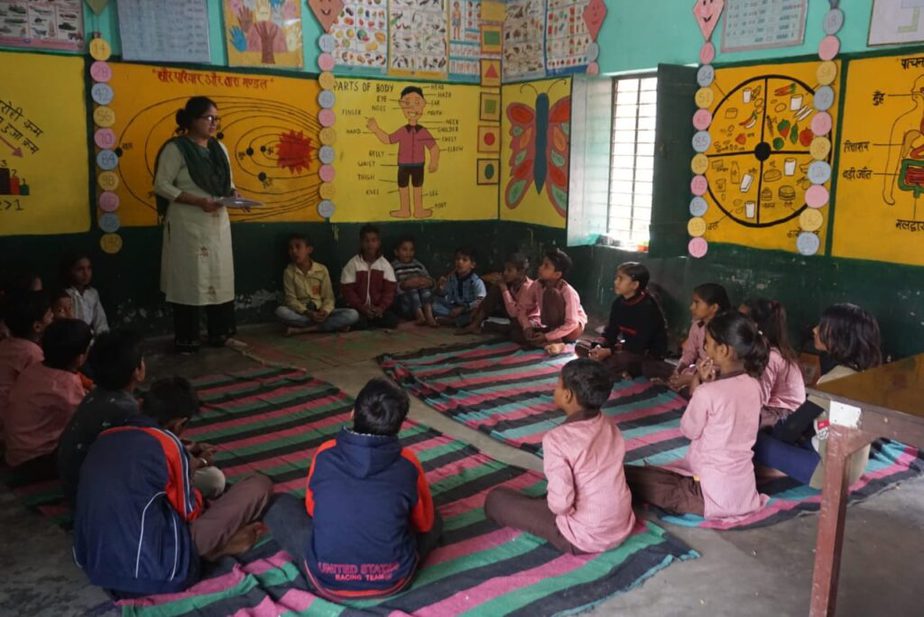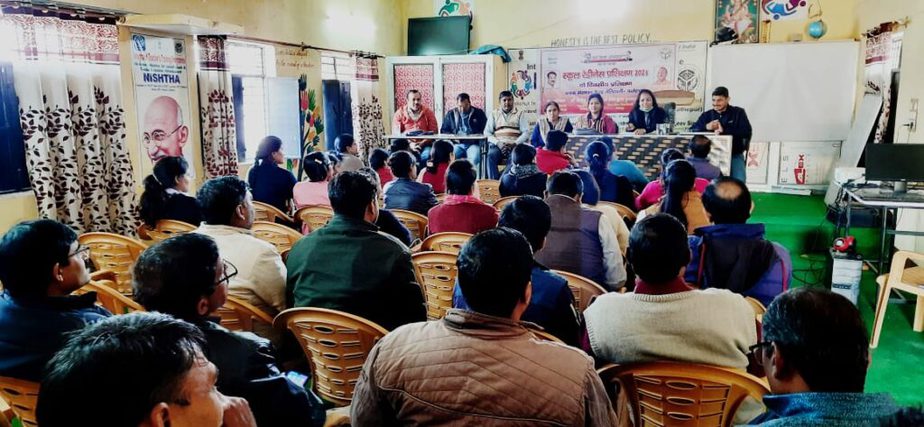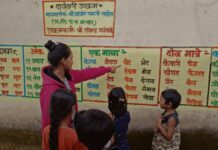The government school system of our country serves over 113 million students annually. However, there exists a vast gap between education and learning especially for the socially marginalized, due to structural inequalities, and poor learning infrastructure and curricula. This can make performing well in the education system seem like a meaningless and often unconquerable challenge. As a consequence, it becomes difficult for both teachers and students from such circumstances to reimagine education as an opportunity that can alter one’s life.
In more extreme evaluations, this results in either anti-social behaviour or a lack of self-worth, which reveals itself in high suicide rates amongst the youth. In 2019, just five Indian states accounted for more than 44% of India’s total 10,335 student suicides—Uttar Pradesh is on this list and separately accounted for 603 student suicides.
To address this state of affairs, Foster & Forge Foundation’s Beacon Educator Fellowship seeks to empower teachers to enable grassroots change. With the vision to make education a purposeful, meaningful, and empowering experience for students, the two-year Fellowship enables government school teachers to learn innovative teaching practices to help re-imagine learning in their classrooms with. In these two years, these teachers, known as the Beacon Fellows, transition their schools into ‘model Prerak schools’ by working closely with children, other teachers, and parents to engender the civic participation and action that lies at the core of Foster & Forge’s pedagogical mantra.
The long-term goal of the model is to transform the lives of Uttar Pradesh’s schoolchildren through innovative teaching that realizes the potential within each student to enhance their life, income, and participation in society. Currently working in all 75 districts in UP, Foster & Forge reaches 3,000 plus teachers and over 1.5 lakh children through its initiatives.
“To strengthen education as a public good, it is important to create a model [of innovative teaching and learning] which can be sustained, scaled, and strengthened organically. That’s how the idea of building a movement of grassroots teacher-leaders through a Fellowship model was laid in 2018. We wanted to go beyond the whim of ‘wanting to create a difference’,” says Foster & Forge Foundation’s Founder, Meghna Chawla. “My experience of teaching built the skill of sharing in me. I believe that whenever I learn something, it’s my responsibility to share it with those around me.”
The nuts and bolts of the Fellowship were refined in 2018 when the Foundation was incubated by TFIx—Teach For India’s incubator which enables education entrepreneurs to launch, sustain, strengthen, and scale two-year high-impact teaching fellowships based on their organization’s context. Chawla notes that during this period, “the focus [of the fellowship] shifted to stakeholder centricity. The core idea was to create a shared vision with these teachers to empower our children through an education that unleashes their own potential, their student’s, and India’s.”
The Context of Teaching in 21st Century Uttar Pradesh
“The children we’re reaching out to through our work come from diverse backgrounds and face a flux of community issues. Their parents are mostly daily wage workers; their struggles often inspire their children to become more responsible. The dreams our students from UP have are twofold: they envision themselves working in a government job for stability, and their entrepreneurial streak encourages them to start their own ventures in the field of education to break through societal power dynamics and empower their communities,” shares Neha Sharma, Program Manager at Foster & Forge, who works towards supporting 210 Beacon Fellows from four of UP’s districts.
Achieving these dreams partially rests on an education system that prioritises student learning through healthy student-to-teacher ratios, facilitating upward mobility. “During the drive to universalise primary education in 2005 in Uttar Pradesh, teachers were posted in diverse areas to cater to all students: be they rural, semi-rural, urban. Their ages range from 28 to 50 years. In those days, the experienced teachers took on the role of headmasters,” shares Chawla.
Yet, this task of scaling public school education in the state was beset with roadblocks—ultimately inhibiting student learning.
“There were several issues that teachers faced on the job in those times, some of which are still existent,” recalls Sheetal Arya, a Program Partner at Foster & Forge, who has worked for six years with the organization and supports seven Program Mentors (or teacher trainers) working in 26 of UP’s 75 districts. Sheetal has been instrumental in designing the Beacon Educator Fellowship, especially in terms of its monitoring and evaluation components, and in facilitating interaction with government authorities. “These issues included poor school infrastructure, staff shortages, a lack of support structures for teachers, and regular student absenteeism as children often took up menial jobs to financially support their families,” she adds. Many teachers during this period had to fight the community to teach in towns where local communities resisted the formalization of universal education.

Decades down the line, these woes carry over into the present, despite education reforms, negatively impacting the ability of teachers to perform their jobs well. There have been multiple layers of digitalisation in the state’s education system, starting from the implementation of Mission Prerna’s Direct Benefit Transfer scheme—the UP government’s initiative to improve the quality of education in 1.1 lakh schools by transitioning all processes to online platforms. Manav Sampada Aadesh is also being executed here to enhance the workflow and increase the accessibility of government departments.
Yet, the responsibility of implementing these policies at the school level falls squarely on government teachers, who already struggle with larger amounts of administrative work, bad student-teacher ratio in schools, and a lack of accountability structures in the public education system. “I have been working in the education sector for the past 13 years in UP’s Sambhal district,” shares Rakhi Agarwal, a government headteacher, who became associated with Foster & Forge Foundation during the lockdown. “There are 600 students across 5 grades in our school and only two teachers including myself to teach them. We also distribute books and uniforms, or milk under the Mid-Day Meal scheme, and collect data for Mission Prerna’s Direct Benefit Transfer scheme and feed it online. There are days when we have to teach our students during prayer time since the rest of the day goes into completing administrative work. It becomes exceedingly difficult to manage all these tasks.”
“In some schools in UP, there are almost 100 students learning under a single teacher,” Chawla adds. “There are days when they are left unattended [as teachers work on implementing government initiatives]. Such situations lead to a loss of the culture of regular classes and adversely affects the learning mindset of students.”
How Does the Fellowship Work?
Chawla’s desire to support teachers and create schools that act as centres for change stemmed from a need to enact structural reforms towards public education in Uttar Pradesh.
“We create an opportunity for India’s largest teacher community—government school teachers—to join this broad people’s movement by transforming their classrooms and inspiring their peers to transition their schools into model schools of learning too,” shares Chawla. “In the short term, our Fellows are exposed to new teaching methodologies and they begin to cultivate the knowledge, skills, and mindsets necessary to attain leadership positions in the education system. They also identify their own role in building a larger movement for a meaningful, excellent education. In the longer run, our alumni become catalysts of change by taking up positions of teacher-trainers, school principals, curriculum designers, and education policy advocates, all of whom are committed to strong advocacy for better education at the systemic level.”
However, the success of all this training ultimately lies within the teacher themselves. “Fellows need to be strongly committed to the vision of every child getting an excellent education. That is the sole driver of all the efforts we take and what enables all the results gained. Without this mindset, the Fellowship will just be an ‘experience’ for the teachers, and may not achieve the desired impact of helping students,” adds Sharma.


Chawla agrees, but believes that developing this leadership mindset is a layered process: it is not only about bettering one’s own practices, but about mobilizing all the stakeholders to strengthen their individual impact too. To this end, the Foundation has designed a leadership framework called the Leadership Development Journey for its Beacon Teachers, whose benefits are to trickle down to students as well.
The curriculum is centred around three commitments. First, the commitment to personal transformation, wherein teachers are encouraged to explore who they are and their purpose, and how they can strive to be a better leader of educational change. Second, the commitment to collective action: where teachers are taught how to build relationships within the school, the community, and other partners to deepen and scale their impact. Third, the commitment to meaningful education, where teachers facilitate experiential classroom experiences to empower each learner for a lifetime.
With the Fellowship steeped in practices surrounding these three commitments, and embedded with real-life leadership experiences in both classrooms and communities, Beacon Fellows eventually become a ‘community’ of lifelong learners and leaders geared towards positively impacting their children. “The fellowship has helped me on multiple levels—it has provided a greater platform for me to develop clarity [regarding the issues I face as a teacher].
In doing so, we [the Fellows] have been able to build a community of teachers [across UP] anchored in a shared vision [of providing quality education] for our students. I now know that I can leverage this ecosystem of [teachers] for [emotional] support, or to share ideas and contextual solutions,” shares Agarwal.

Agarwal’s engagement with other government teachers in UP is intentional—given that network building is a key facet of the fellowship’s design. “We believe in stakeholder investment and building a community of good practitioners,” explains Chawla. “We work with 20 or more teachers in a single batch of Fellows. These teachers are usually teaching under the same block within a district, which unites them. These different batches take part in Learning Circles with teachers of different districts, to network and build long term synergies when it comes to education.”
The Road Ahead
One year into the fellowship, Agarwal has clearer goals in mind when it comes to supporting her students. “I envision working with students on the 17 Sustainable Development Goals to strengthen their engagement with the communities [they want to give back to]. Through the fellowship, we have also built a cadre of teachers who take ownership over making students socially aware through developing their problem solving and leadership skills.”
Yet, with such a large-scale model, one also wonders about how the Fellowship’s impact can be evaluated at the ground level. Together with the accumulated knowledge of experienced professionals in the domain, actual on-ground learnings, and local and national inputs, the Foundation has developed scoring rubrics modelled on it its vision scales.
The Fellows are scored on the Beacon Vision Scale and a Student Vision Scale. Both systematically evaluate their development of life skills, which include confidence and self-belief, as well as professional competencies, such as the ability to express clearly, adapt to new environments, and make well-rounded decisions. The frameworks also have components in place to measure values and mindset shifts, as well as the uptake in community action and participation during the fellowship.

“We conduct Leadership Development Conversations every quarter using these rubrics. These assessments help to fill the gaps in our knowledge. However, our processes to measure impact on the system are constantly evolving to yield authentic and conclusive results,” says Chawla. “Through this, our Fellowship has been crucial in introducing us to a range of issues that exist at the school, community, and system level. We don’t need convincing that education is an effective tool to transform our state and the society, what we need is effective and prioritized action.”
Chawla also shares her hopes to deepen Foster & Forge’s work with the new pipeline of incoming teacher fellows next year: her dream is to ensure that there is a Beacon Fellow in every government school to change the learning trajectory of every child in Uttar Pradesh.
Featured image: A Foster & Forge Program Mentor holding an ‘Observation Debrief Conversation’ where the strengths and areas of improvement of the lesson conducted by the Beacon Teacher are discussed; courtesy of Foster & Forge.





